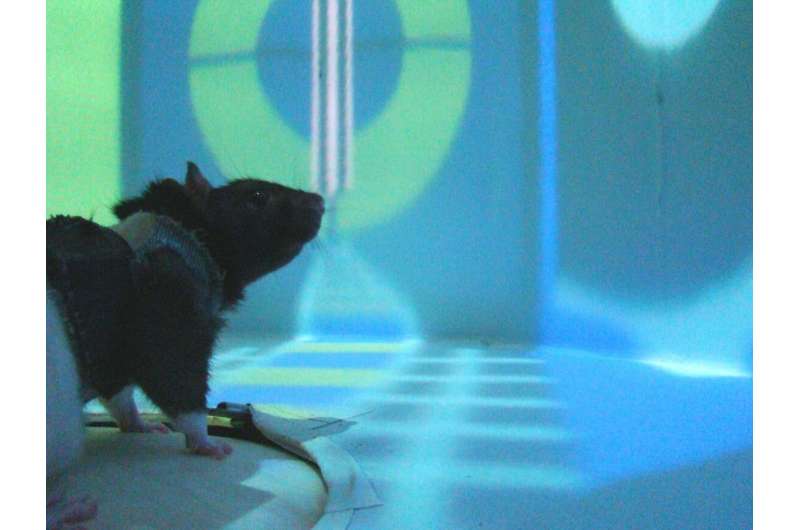VR experiment with rats offers new insights about how neurons enable learning

Scientists have long understood that the region of the brain called the hippocampus is important for memory, learning and navigation.
Now, scientists in a UCLA lab led by neurophysicist Mayank Mehta are gaining a deeper understanding of how the hippocampus works on a circuit level—that is, functions involving networks of millions of neurons. That knowledge could be an important step toward the development of treatments for neurological disorders such as Alzheimer’s disease, schizophrenia and epilepsy, all of which are related to dysfunction in the hippocampus.
In their latest study, published in the journal Nature, the scientists studied rats in a virtual reality maze. While observing the activities of large numbers of individual neurons in each animal’s hippocampus, the scientists discovered responses in those neurons that revealed a specific mechanism for navigation.
“The hippocampus is one of the first regions to be affected in memory-based diseases like Alzheimer’s,” said the study’s lead author, Jason Moore, a former UCLA postdoctoral scholar who is now at New York University. “So it is crucial to understand its functionality, flexibility and limits.”
The study could help explain why people with damage to the hippocampus struggle not just with so-called spatial tasks, like finding their way home or locating a lost set of keys, but also with memory tasks, such as recalling what they had for lunch or whether they took their daily medication.
The experiment used a type of virtual reality system that was developed in Mehta’s lab. The technology is intended to keep the animals comfortable and avoid causing dizziness and other symptoms that other VR systems can trigger.
For the study, rats were placed on a small treadmill inside a box with images of a maze projected onto the container’s walls. The rats were encouraged to run through the maze to find their reward, a drop of sugar water. In order to make it to the reward, rats needed to discern where they were in relation to the virtual objects around them, where they needed to go to receive their rewards and how far away the destination was.
Several animals were tested over many sessions, enabling the researchers to observe how the neurons’ responses changed as the rats learned to navigate the maze.
The scientists observed that hippocampal neurons encoded multiple aspects of the animal’s location—where it is in space, the angle of its body relative to its reward and how far it has moved along its path—a phenomenon called “multiplexing.”
That finding is significant because it had been widely thought that neurons in the hippocampus code only for position.
“We found that in the virtual maze, the neurons carry very little information about the rat’s position,” said Mehta, a UCLA professor of neurology, neurobiology and physics. “Instead, most neurons encode for other aspects of navigation, such as distance traveled and which direction the body is heading.”
The scientists also observed that as the rats gained experience in the maze, their neurons “remembered” the maze even more reliably and accurately.
Research in Mehta’s lab and elsewhere over the past 25 years has shown that such changes in neurons’ activity—or neuroplasticity—occur via a process neuroscientists call Hebbian learning. That process is mediated by a neurochemical called NMDA, which is a common target for drugs used to treat neurological disorders.
Mehta said the neuroplasticity scientists observed in the rats is likely due to Hebbian learning across billions of synapses. That conclusion was further proven when the researchers injected the animals with substances to inhibit their NMDA, which impaired their performance in the maze.
“Remarkably, neuroplasticity was far greater in the virtual reality environment than in simpler, real-world mazes,” Mehta said. “Further, this boosted neuroplasticity was related to performance.”
Also contributing to the research were co-authors Jesse Cushman, Lavanya Acharya and Brianna Popeny, all of UCLA, as well as several UCLA undergraduate students.
Source: Read Full Article
